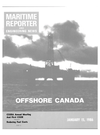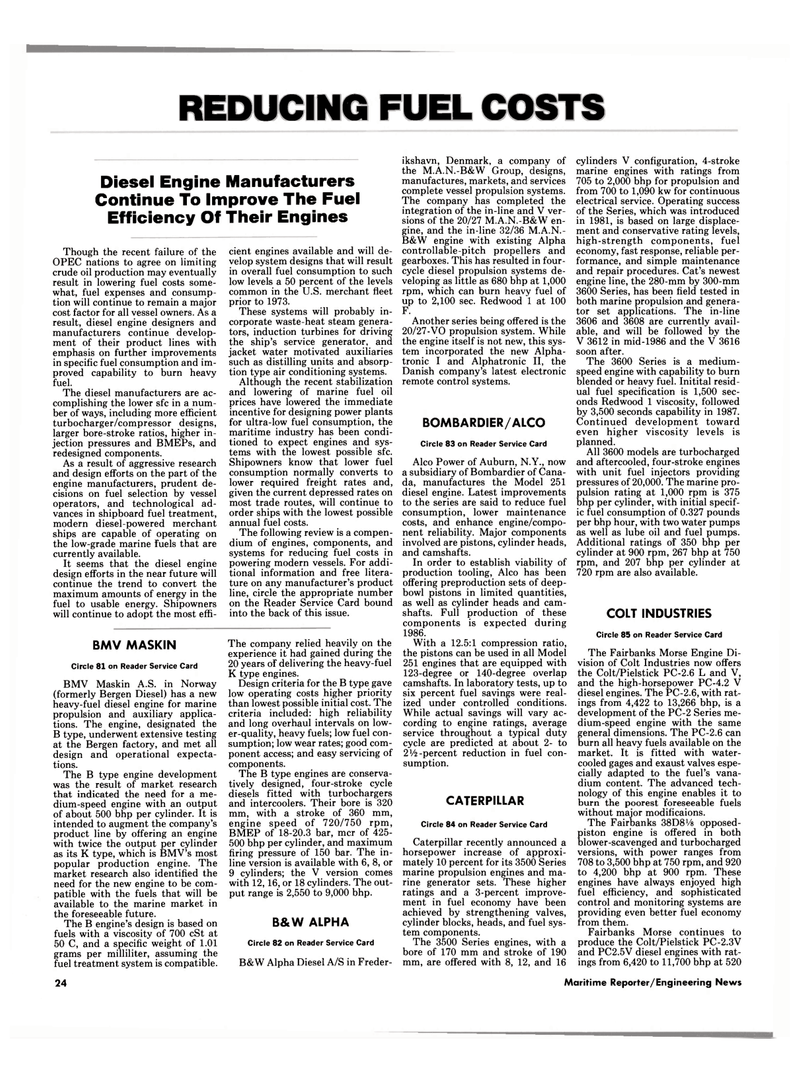
Page 22: of Maritime Reporter Magazine (January 15, 1986)
Read this page in Pdf, Flash or Html5 edition of January 15, 1986 Maritime Reporter Magazine
REDUCING FUEL COSTS
Diesel Engine Manufacturers
Continue To Improve The Fuel
Efficiency Of Their Engines
Though the recent failure of the
OPEC nations to agree on limiting crude oil production may eventually result in lowering fuel costs some- what, fuel expenses and consump- tion will continue to remain a major cost factor for all vessel owners. As a result, diesel engine designers and manufacturers continue develop- ment of their product lines with emphasis on further improvements in specific fuel consumption and im- proved capability to burn heavy fuel.
The diesel manufacturers are ac- complishing the lower sfc in a num- ber of ways, including more efficient turbocharger/compressor designs, larger bore-stroke ratios, higher in- jection pressures and BMEPs, and redesigned components.
As a result of aggressive research and design efforts on the part of the engine manufacturers, prudent de- cisions on fuel selection by vessel operators, and technological ad- vances in shipboard fuel treatment, modern diesel-powered merchant ships are capable of operating on the low-grade marine fuels that are currently available.
It seems that the diesel engine design efforts in the near future will continue the trend to convert the maximum amounts of energy in the fuel to usable energy. Shipowners will continue to adopt the most effi- cient engines available and will de- velop system designs that will result in overall fuel consumption to such low levels a 50 percent of the levels common in the U.S. merchant fleet prior to 1973.
These systems will probably in- corporate waste-heat steam genera- tors, induction turbines for driving the ship's service generator, and jacket water motivated auxiliaries such as distilling units and absorp- tion type air conditioning systems.
Although the recent stabilization and lowering of marine fuel oil prices have lowered the immediate incentive for designing power plants for ultra-low fuel consumption, the maritime industry has been condi- tioned to expect engines and sys- tems with the lowest possible sfc.
Shipowners know that lower fuel consumption normally converts to lower required freight rates and, given the current depressed rates on most trade routes, will continue to order ships with the lowest possible annual fuel costs.
The following review is a compen- dium of engines, components, and systems for reducing fuel costs in powering modern vessels. For addi- tional information and free litera- ture on any manufacturer's product line, circle the appropriate number on the Reader Service Card bound into the back of this issue.
BMV MASKIN
Circle 81 on Reader Service Card
BMV Maskin A.S. in Norway (formerly Bergen Diesel) has a new heavy-fuel diesel engine for marine propulsion and auxiliary applica- tions. The engine, designated the
B type, underwent extensive testing at the Bergen factory, and met all design and operational expecta- tions.
The B type engine development was the result of market research that indicated the need for a me- dium-speed engine with an output of about 500 bhp per cylinder. It is intended to augment the company's product line by offering an engine with twice the output per cylinder as its K type, which is BMV's most popular production engine. The market research also identified the need for the new engine to be com- patible with the fuels that will be available to the marine market in the foreseeable future.
The B engine's design is based on fuels with a viscosity of 700 cSt at 50 C, and a specific weight of 1.01 grams per milliliter, assuming the fuel treatment system is compatible.
The company relied heavily on the experience it had gained during the 20 years of delivering the heavy-fuel
K type engines.
Design criteria for the B type gave low operating costs higher priority than lowest possible initial cost. The criteria included: high reliability and long overhaul intervals on low- er-quality, heavy fuels; low fuel con- sumption; low wear rates; good com- ponent access; and easy servicing of components.
The B type engines are conserva- tively designed, four-stroke cycle diesels fitted with turbochargers and intercoolers. Their bore is 320 mm, with a stroke of 360 mm, engine speed of 720/750 rpm,
BMEP of 18-20.3 bar, mcr of 425- 500 bhp per cylinder, and maximum firing pressure of 150 bar. The in- line version is available with 6, 8, or 9 cylinders; the V version comes with 12,16, or 18 cylinders. The out- put range is 2,550 to 9,000 bhp.
B&W ALPHA
Circle 82 on Reader Service Card
B&W Alpha Diesel A/S in Freder- ikshavn, Denmark, a company of the M.A.N.-B&W Group, designs, manufactures, markets, and services complete vessel propulsion systems.
The company has completed the integration of the in-line and V ver- sions of the 20/27 M.A.N.-B&W en- gine, and the in-line 32/36 M.A.N.-
B&W engine with existing Alpha controllable-pitch propellers and gearboxes. This has resulted in four- cycle diesel propulsion systems de- veloping as little as 680 bhp at 1,000 rpm, which can burn heavy fuel of up to 2,100 sec. Redwood 1 at 100
F.
Another series being offered is the 20/27-VO propulsion system. While the engine itself is not new, this sys- tem incorporated the new Alpha- tronic I and Alphatronic II, the
Danish company's latest electronic remote control systems.
BOMBARDIER/ALCO
Circle 83 on Reader Service Card
Alco Power of Auburn, N.Y., now a subsidiary of Bombardier of Cana- da, manufactures the Model 251 diesel engine. Latest improvements to the series are said to reduce fuel consumption, lower maintenance costs, and enhance engine/compo- nent reliability. Major components involved are pistons, cylinder heads, and camshafts.
In order to establish viability of production tooling, Alco has been offering preproduction sets of deep- bowl pistons in limited quantities, as well as cylinder heads and cam- shafts. Full production of these components is expected during 1986.
With a 12.5:1 compression ratio, the pistons can be used in all Model 251 engines that are equipped with 123-degree or 140-degree overlap camshafts. In laboratory tests, up to six percent fuel savings were real- ized under controlled conditions.
While actual savings will vary ac- cording to engine ratings, average service throughout a typical duty cycle are predicted at about 2- to 2 V2 -percent reduction in fuel con- sumption.
CATERPILLAR
Circle 84 on Reader Service Card
Caterpillar recently announced a horsepower increase of approxi- mately 10 percent for its 3500 Series marine propulsion engines and ma- rine generator sets. These higher ratings and a 3-percent improve- ment in fuel economy have been achieved by strengthening valves, cylinder blocks, heads, and fuel sys- tem components.
The 3500 Series engines, with a bore of 170 mm and stroke of 190 mm, are offered with 8, 12, and 16 cylinders V configuration, 4-stroke marine engines with ratings from 705 to 2,000 bhp for propulsion and from 700 to 1,090 kw for continuous electrical service. Operating success of the Series, which was introduced in 1981, is based on large displace- ment and conservative rating levels, high-strength components, fuel economy, fast response, reliable per- formance, and simple maintenance and repair procedures. Cat's newest engine line, the 280-mm by 300-mm 3600 Series, has been field tested in both marine propulsion and genera- tor set applications. The in-line 3606 and 3608 are currently avail- able, and will be followed by the
V 3612 in mid-1986 and the V 3616 soon after.
The 3600 Series is a medium- speed engine with capability to burn blended or heavy fuel. Initital resid- ual fuel specification is 1,500 sec- onds Redwood 1 viscosity, followed by 3,500 seconds capability in 1987.
Continued development toward even higher viscosity levels is planned.
All 3600 models are turbocharged and aftercooled, four-stroke engines with unit fuel injectors providing pressures of 20,000. The marine pro- pulsion rating at 1,000 rpm is 375 bhp per cylinder, with initial specif- ic fuel consumption of 0.327 pounds per bhp hour, with two water pumps as well as lube oil and fuel pumps.
Additional ratings of 350 bhp per cylinder at 900 rpm, 267 bhp at 750 rpm, and 207 bhp per cylinder at 720 rpm are also available.
COLT INDUSTRIES
Circle 85 on Reader Service Card
The Fairbanks Morse Engine Di- vision of Colt Industries now offers the Colt/Pielstick PC-2.6 L and V, and the high-horsepower PC-4.2 V diesel engines. The PC-2.6, with rat- ings from 4,422 to 13,266 bhp, is a development of the PC-2 Series me- dium-speed engine with the same general dimensions. The PC-2.6 can burn all heavy fuels available on the market. It is fitted with water- cooled gages and exaust valves espe- cially adapted to the fuel's vana- dium content. The advanced tech- nology of this engine enables it to burn the poorest foreseeable fuels without major modificaions.
The Fairbanks 38D8'/8 opposed- piston engine is offered in both blower-scavenged and turbocharged versions, with power ranges from 708 to 3,500 bhp at 750 rpm, and 920 to 4,200 bhp at 900 rpm. These engines have always enjoyed high fuel efficiency, and sophisticated control and monitoring systems are providing even better fuel economy from them.
Fairbanks Morse continues to produce the Colt/Pielstick PC-2.3V and PC2.5V diesel engines with rat- ings from 6,420 to 11,700 bhp at 520 24 Maritime Reporter/Engineering News

 21
21

 23
23
